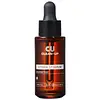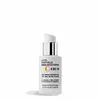What's inside
What's inside
 Key Ingredients
Key Ingredients

 Benefits
Benefits

 Concerns
Concerns

No concerns
 Ingredients Side-by-side
Ingredients Side-by-side

Water
Skin ConditioningSodium Ascorbyl Phosphate 5%
AntioxidantButylene Glycol
Humectant1,2-Hexanediol
Skin ConditioningEthoxydiglycol
HumectantCarbomer
Emulsion StabilisingArginine
MaskingGlycerin
HumectantCaprylic/Capric Triglyceride
MaskingBetaine
HumectantPolyglyceryl-10 Laurate
Skin ConditioningNiacinamide
SmoothingHydrogenated Lecithin
EmulsifyingHexylglycerin
HumectantHydroxydecyl Ubiquinone
AntioxidantViscum Album (Mistletoe)
3-O-Ethyl Ascorbic Acid
Skin ConditioningAscorbic Acid
AntioxidantCaprylyl Glycol
EmollientWater, Sodium Ascorbyl Phosphate 5%, Butylene Glycol, 1,2-Hexanediol, Ethoxydiglycol, Carbomer, Arginine, Glycerin, Caprylic/Capric Triglyceride, Betaine, Polyglyceryl-10 Laurate, Niacinamide, Hydrogenated Lecithin, Hexylglycerin, Hydroxydecyl Ubiquinone, Viscum Album (Mistletoe), 3-O-Ethyl Ascorbic Acid, Ascorbic Acid, Caprylyl Glycol
Hyaluronic Acid
HumectantTripeptide-5
Skin ConditioningOleanolic Acid
Skin ConditioningSqualane
EmollientAscorbic Acid 15%
AntioxidantTetrahexyldecyl Ascorbate
AntioxidantTocopherol
AntioxidantNiacinamide 3%
SmoothingWater
Skin ConditioningPropylheptyl Caprylate
EmollientGlycerin
HumectantPentylene Glycol
Skin ConditioningDicaprylyl Ether
EmollientButylene Glycol
HumectantSucrose Polystearate
EmollientUndecane
EmollientCetearyl Alcohol
EmollientDisodium Cetearyl Sulfosuccinate
CleansingPhenoxyethanol
PreservativeTridecane
PerfumingHelianthus Annuus Seed Oil
EmollientCetyl Palmitate
EmollientAlcohol
AntimicrobialXanthan Gum
EmulsifyingCitric Acid
BufferingDisodium EDTA
Enantia Chlorantha Bark Extract
Skin ConditioningEthylhexylglycerin
Skin ConditioningGlyceryl Citrate/Lactate/Linoleate/Oleate
EmulsifyingPolyglyceryl-2 Oleate
EmulsifyingCaprylic/Capric Triglyceride
MaskingSodium Acetylated Hyaluronate
HumectantSodium Hyaluronate
HumectantSodium Hyaluronate Crosspolymer
HumectantAscorbyl Palmitate
AntioxidantHydrolyzed Sodium Hyaluronate
Skin ConditioningPalmitoyl Tripeptide-5
Skin ConditioningDimethylmethoxy Chromanol
AntioxidantHyaluronic Acid, Tripeptide-5, Oleanolic Acid, Squalane, Ascorbic Acid 15%, Tetrahexyldecyl Ascorbate, Tocopherol, Niacinamide 3%, Water, Propylheptyl Caprylate, Glycerin, Pentylene Glycol, Dicaprylyl Ether, Butylene Glycol, Sucrose Polystearate, Undecane, Cetearyl Alcohol, Disodium Cetearyl Sulfosuccinate, Phenoxyethanol, Tridecane, Helianthus Annuus Seed Oil, Cetyl Palmitate, Alcohol, Xanthan Gum, Citric Acid, Disodium EDTA, Enantia Chlorantha Bark Extract, Ethylhexylglycerin, Glyceryl Citrate/Lactate/Linoleate/Oleate, Polyglyceryl-2 Oleate, Caprylic/Capric Triglyceride, Sodium Acetylated Hyaluronate, Sodium Hyaluronate, Sodium Hyaluronate Crosspolymer, Ascorbyl Palmitate, Hydrolyzed Sodium Hyaluronate, Palmitoyl Tripeptide-5, Dimethylmethoxy Chromanol
Ingredients Explained
These ingredients are found in both products.
Ingredients higher up in an ingredient list are typically present in a larger amount.
Ascorbic Acid is is pure Vitamin C. This form makes up the largest amount of vitamin C found naturally in our skin.
Not only is vitamin C great for your overall health and immune system, it also has plenty of benefits on your skin.
Vitamin C is best used for brightening skin. It improves dark spots, acne scars, and hyperpigmentation. This is because it blocks the process of skin darkening when exposed to UV.
Remember: Vitamin C should not replace sunscreen!
Your skin uses vitamin C to build collagen. Collagen is one key component in having a strong skin barrier and plump skin. Vitamin C also plays a role in regulating collagen, thus making it effective in improving wrinkles and fine lines.
Ascorbic acid shows potent antioxidant activity. As an antioxidant, it helps fight free-radicals. Free-radicals are molecules that may damage your skin cells. These antioxidants also protect skin against UV damage.
The best formulations include Vitamin E and/or ferulic acid. These two ingredients help stabilize and provide a boost in the benefits of ascorbic acid. This is because ascorbic acid becomes unstable when exposed to UV and air. In fact, you can tell your ascorbic acid has oxidized when it turns an orange-yellow color.
Ascorbic acid is generally compatible with other ingredients. However, using ascorbic acid with other active ingredients might cause irritation. Two ingredients: copper ions and benzoyl peroxide, will inactivate ascorbic acid completely.
Read more about other types of Vitamin C:
Foods rich with vitamin C include oranges, strawberries, broccoli, bell peppers, and more. When consuming Vitamin C, your skin receives a portion of the nutrients.
Learn more about Ascorbic AcidButylene Glycol (or BG) is used within cosmetic products for a few different reasons:
Overall, Butylene Glycol is a safe and well-rounded ingredient that works well with other ingredients.
Though this ingredient works well with most skin types, some people with sensitive skin may experience a reaction such as allergic rashes, closed comedones, or itchiness.
Learn more about Butylene GlycolThis ingredient is an emollient, solvent, and texture enhancer. It is considered a skin-softener by helping the skin prevent moisture loss.
It helps thicken a product's formula and makes it easier to spread by dissolving clumping compounds.
Caprylic Triglyceride is made by combining glycerin with coconut oil, forming a clear liquid.
While there is an assumption Caprylic Triglyceride can clog pores due to it being derived from coconut oil, there is no research supporting this.
Learn more about Caprylic/Capric TriglycerideGlycerin is already naturally found in your skin. It helps moisturize and protect your skin.
A study from 2016 found glycerin to be more effective as a humectant than AHAs and hyaluronic acid.
As a humectant, it helps the skin stay hydrated by pulling moisture to your skin. The low molecular weight of glycerin allows it to pull moisture into the deeper layers of your skin.
Hydrated skin improves your skin barrier; Your skin barrier helps protect against irritants and bacteria.
Glycerin has also been found to have antimicrobial and antiviral properties. Due to these properties, glycerin is often used in wound and burn treatments.
In cosmetics, glycerin is usually derived from plants such as soybean or palm. However, it can also be sourced from animals, such as tallow or animal fat.
This ingredient is organic, colorless, odorless, and non-toxic.
Glycerin is the name for this ingredient in American English. British English uses Glycerol/Glycerine.
Learn more about GlycerinNiacinamide is a multitasking form of vitamin B3 that strengthens the skin barrier, reduces pores and dark spots, regulates oil, and improves signs of aging.
And the best part? It's gentle and well-tolerated by most skin types, including sensitive and reactive skin.
You might have heard of "niacin flush", or the reddening of skin that causes itchiness. Niacinamide has not been found to cause this.
In very rare cases, some individuals may not be able to tolerate niacinamide at all or experience an allergic reaction to it.
If you are experiencing flaking, irritation, and dryness with this ingredient, be sure to double check all your products as this ingredient can be found in all categories of skincare.
When incorporating niacinamide into your routine, look out for concentration amounts. Typically, 5% niacinamide provides benefits such as fading dark spots. However, if you have sensitive skin, it is better to begin with a smaller concentration.
When you apply niacinamide to your skin, your body converts it into nicotinamide adenine dinucleotide (NAD). NAD is an essential coenzyme that is already found in your cells as "fuel" and powers countless biological processes.
In your skin, NAD helps repair cell damage, produce new healthy cells, support collagen production, strengthen the skin barrier, and fight environmental stressors (like UV and pollution).
Our natural NAD levels start to decline with age, leading to slower skin repair, visible aging, and a weaker skin barrier. By providing your skin niacinamide, you're recharging your skin's NAD levels. This leads to stronger, healthier, and younger looking skin.
Another name for vitamin B3 is nicotinamide. This vitamin is water-soluble and our bodies don't store it. We obtain Vitamin B3 from either food or skincare. Meat, fish, wheat, yeast, and leafy greens contain vitamin B3.
The type of niacinamide used in skincare is synthetically created.
Learn more about NiacinamideWater. It's the most common cosmetic ingredient of all. You'll usually see it at the top of ingredient lists, meaning that it makes up the largest part of the product.
So why is it so popular? Water most often acts as a solvent - this means that it helps dissolve other ingredients into the formulation.
You'll also recognize water as that liquid we all need to stay alive. If you see this, drink a glass of water. Stay hydrated!
Learn more about Water